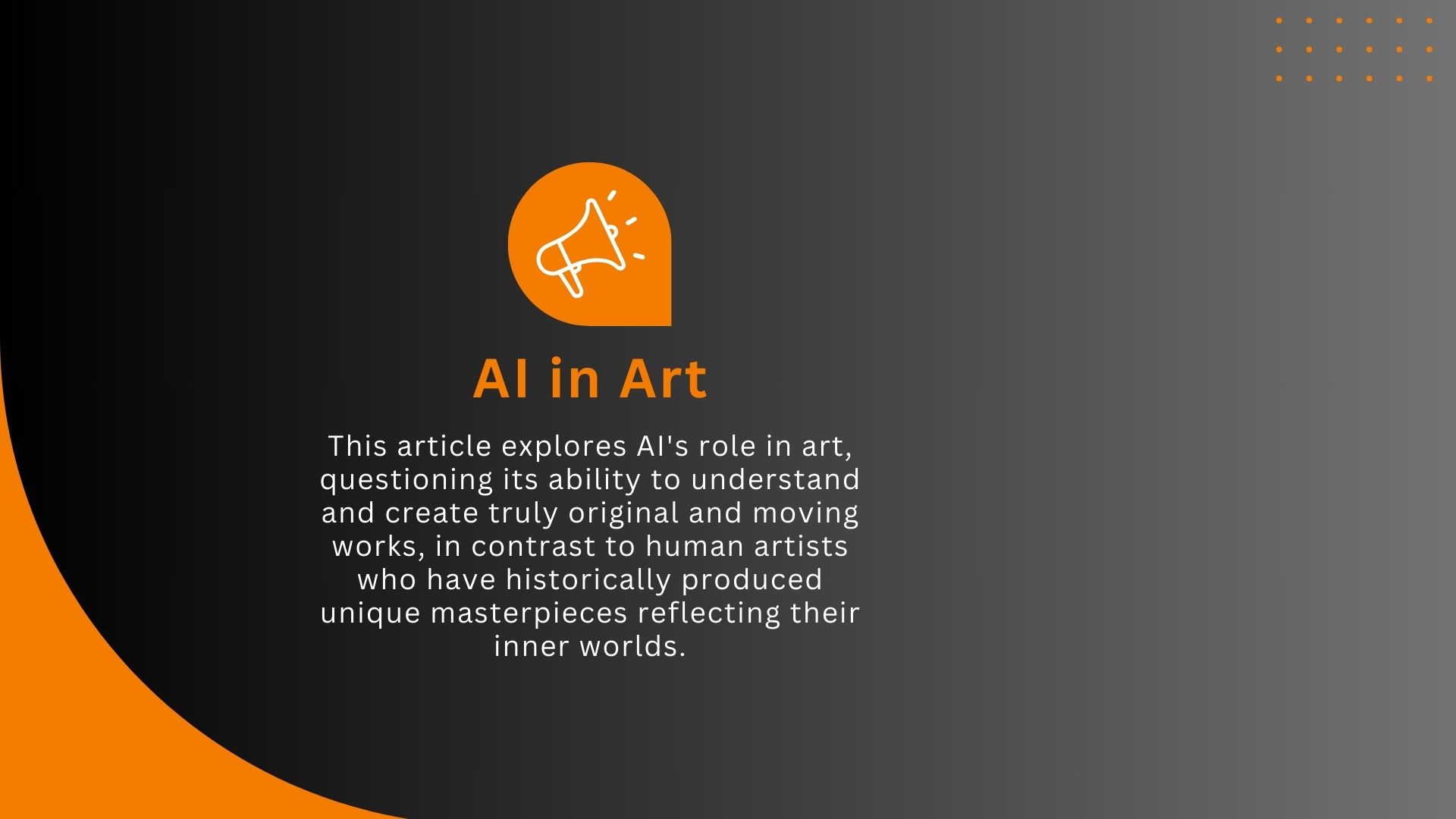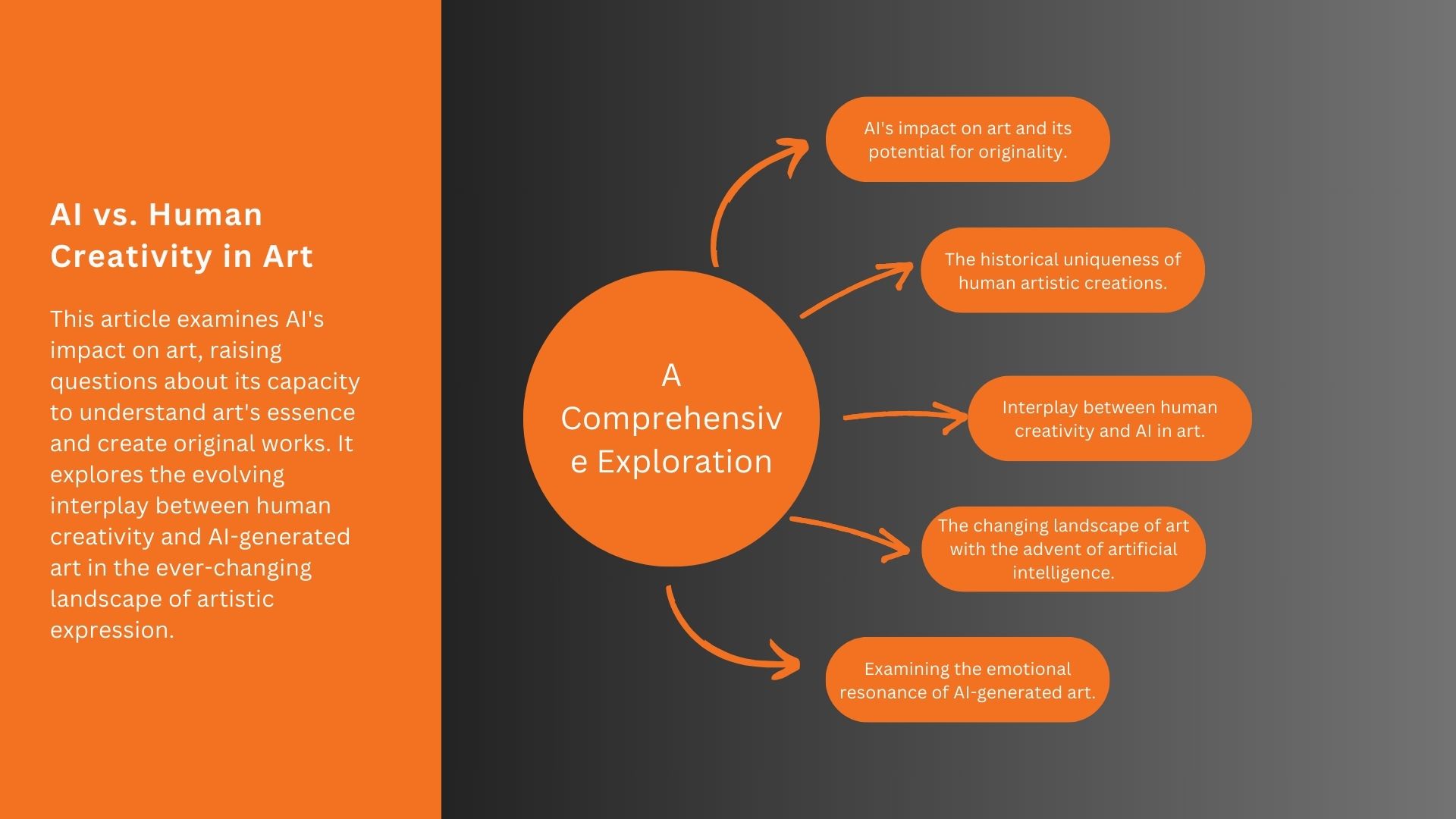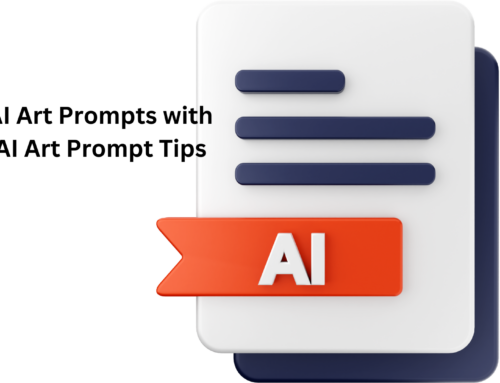Art has always been a captivating mirror reflecting the depths of human imagination. Throughout history, artists have channeled their creativity to create awe-inspiring masterpieces, each a unique fingerprint of their inner world. But what happens when machines join the creative club? Can AI truly understand the essence of art and produce original, soul-stirring works? In this article, we dive into the world of AI-generated art, exploring the dynamic interplay between originality and creativity using AI art.

Creativity Beyond the Algorithm
Artificial Intelligence has not just been revolutionizing industries like healthcare, finance, and transportation; it’s also flexing its digital muscles in the realm of art. AI algorithms are now capable of generating art pieces that challenge our perceptions of creativity and originality. But are they mere imitators or true creators?
Hilary P Johnson, Artificial Intelligence Enthusiast and a Business Growth Coach emphasizes “We have been using MidJourney to create art for our businesses (social media, websites, newsletters, etc.) and it’s really been a lot of fun. None of our internal team members are graphic artists, so it’s commonly something we would hire for, but it’s also something we don’t have a huge budget for. So by using MidJourney we can get creative and play with prompts that allow us to generate art that’s on brand, engaging, and honestly well beyond what we would have requested in a creative brief. It’s also fast and iterative, so we can get graphics that are amazing on the fly, while also iterating many many times until we get exactly what we want.”
AI creates original music, art, and poetry by mimicking human creativity through advanced machine learning techniques. These systems are trained on extensive datasets, including compositions, artworks, and literary works, enabling them to recognize and replicate patterns, styles, and structures. For example, in music, AI analyzes melodies, harmonies, and rhythms to compose unique pieces that resonate with listeners. In art, it studies brushstroke techniques, color palettes, and composition rules to create visually stunning digital paintings. Similarly, in poetry, AI understands meter, rhyme, and thematic expressions to craft verses that evoke emotion.
How does AI create original music, art, and poetry?
Paul DeMott, the Chief Technology Officer at Helium SEO, explains, “AI generates creative works by using advanced models trained on vast datasets of existing human-made content. For example, tools like OpenAI’s GPT-4 or Google’s MusicLM analyze patterns—melody structures in music, brushstroke styles in paintings, or rhyme schemes in poetry—and then recombine these elements to create something new. A real-world example is AI-generated music, like the deep-learning-based compositions of AIVA, used in film scores. While these outputs often feel fresh, they’re rooted in mathematical interpretations of human creativity. This raises the question: is it really “original,” or just a remix of what’s already out there?”
Exploring the World of AI Tools: From DALL-E to Midjourney
Let’s delve into the fascinating realm of AI art generators, where technology meets art and creativity head-on. From DALL-E to Midjourney, these computational creativity powerhouses are reshaping the art and design landscape. Art competitions now feature AI-generated images alongside traditional art, highlighting the growing influence of AI in the art world. AI systems are proving to be invaluable tools in the hands of artists, sparking discussions about the future of AI and how art is created. In the world of art, the use of AI tools is driving the creation of new art forms, blurring the lines between what’s generated by AI and what’s crafted by human artists, showcasing a captivating case of AI working alongside creative minds to produce free-spirited, innovative art with the infusion of new AI techniques. It’s an exciting era where AI is being used not to replace human art but to enhance and expand the boundaries of what’s possible in visual art.
AI’s Influence on Human Creativity
AI generates art by analyzing patterns and data. It’s not an artist with dreams, emotions, and experiences. Yet, it can surprise us with its ingenuity. AI is a tool that pushes the boundaries of our imagination, helping us discover novel ways of expression.
Abhishek Shah, The Founder of Testlify highlights the ethical considerations surrounding AI-generated art “AI art generation has undeniably broadened the creative landscape for artists in two distinct ways. Firstly, it provides a novel source of inspiration by generating unique ideas and styles based on vast datasets. This exposes artists to unconventional concepts they may not have explored otherwise, sparking new avenues of creativity.
However, concerns arise regarding the originality of AI-generated art. AI, while proficient at mimicking styles and patterns, lacks the depth of human emotions and experiences. This can lead to a proliferation of superficially similar artworks, diluting the essence of human creativity.
To address this, artists should embrace AI as a tool rather than a replacement for their creativity. By using AI to augment their work, artists can maintain their distinctiveness and infuse AI-generated ideas with their unique human touch.”
AI-Powered Creativity Beyond Art and Words
In addition to visual art, AI is also making its presence known in other creative domains. Tools like ChatGPT, which I happen to be a part of, are pushing the boundaries of language and conversation. They assist writers, marketers, and even individuals in crafting compelling narratives, answering questions, and generating text that resonates with human emotions. Similarly, music composition AI programs are creating harmonious melodies, and AI-driven video editors are revolutionizing the world of filmmaking. These diverse AI tools are not just transforming creative processes but also sparking new possibilities, expanding our horizons, and redefining what it means to be creative in the digital age.
Neelabja Adkuloo, Sr. Content Marketing Manager at Mailmodo acknowledges “We’ve been playing around with ChatGPT to support our research work for SEO guides, like analyzing the top search results for “AI content marketing” and extracting headers and interesting topics that haven’t been covered yet. It’s been quite helpful, to be honest!
We’ve also dabbled in using AI for social media copies and even for creating content briefs and writing descriptions for our listicle articles. It definitely speeds up the process and makes things more efficient.
But, here’s the thing… AI has its limitations. When it comes to creating human content that connects with readers, sharing an expert point of view, and considering the customer journey, AI falls short. It just can’t replicate that human touch and understanding.”

Advancements in AI-Generated Art
Advancements in AI art generators have revolutionized the creative landscape, allowing artists to harness the power of natural language and generative adversarial networks. Artists are increasingly using AI as a tool to complement their creative work, blurring the lines between art and AI. With tools like these, artificial intelligence has become a driving force behind the creation of both new and existing art. It’s a symbiotic relationship where AI may aid the creative process, but the final output remains a collaborative effort between the artist and the AI. In this evolving field of artificial intelligence, AI can generate unique pieces of art that challenge our perception of what’s possible, while still preserving the essence of human intelligence.
Here are five key points highlighting the impact of AI in the art world:
- New Creative Avenues: AI has opened up new creative avenues for artists, enabling them to explore uncharted territory and experiment with novel artistic expressions.
- Collaboration, Not Replacement: Rather than replacing artists, AI is working alongside them, augmenting their abilities and offering fresh perspectives in the process of creating art.
- Generative Art: The emergence of generative art, created with AI assistance, showcases the fascinating blend of human and artificial creativity.
- AI-Generated Art: AI can generate art pieces that are truly unique, challenging traditional notions of authorship and originality in the art world.
- Surrounding AI: The discourse surrounding AI and art continues to evolve, sparking discussions about the nature of creativity, collaboration, and the boundaries of human intelligence in the realm of art.
How AI Image Generators Are Amplifying Human Creativity Using AI Art?
AI image generators are turning the art world on its head, and it’s an art revolution like no other. What used to be solely in the hands of human artists is now a dynamic interplay between human creativity and AI assistance. With the ability to generate art, AI is reshaping the concept of what art refers to, challenging art critics and filling art galleries with a new wave of AI-created masterpieces. As several AI companies develop different AI tools for concept art and beyond, the process of creating AI-generated art becomes more accessible to everyone. AI allows artists to use artificial intelligence as a powerful tool in their creative toolkit, expanding the boundaries of what human-made art can be. It’s a fascinating era where the art world is evolving, thanks to the boundless possibilities that AI brings to the canvas.
AI Artists and the Creative Power of Machine Intelligence
AI artists are at the forefront of the AI art revolution, showcasing the immense creative power of machine intelligence. These AI models, backed by advanced machine learning and neural networks, are transforming the landscape of digital art. What sets them apart is their ability to generate art through generative AI techniques like stable diffusion. Contrary to common misconceptions, AI doesn’t replace human creativity using AI Art; instead, it enhances it. Artists are increasingly recognizing the potential of AI technology as a valuable tool in their creative arsenal. The synergy between AI and creativity is redefining how we make art, pushing the boundaries of what’s possible in the ever-evolving world of AI art.
What are the limitations of AI in generating culturally sensitive content?
AI has some clear limitations when it comes to creating culturally sensitive content. Since it learns from large datasets, the quality and diversity of the data directly impact its outputs. Unfortunately, historical data often carries biases, stereotypes, or outdated perspectives, which can result in unintentional misrepresentation of certain cultures. For example, an AI trained mostly on Western-focused data might struggle to depict non-Western traditions accurately, leading to content that feels disconnected or insensitive.
The problem gets worse when AI lacks exposure to diverse cultural examples. For instance, indigenous practices or regional nuances may not be well-represented in the data, causing gaps in understanding. Moreover, AI doesn’t have the ability to grasp the emotional and historical context behind cultural symbols, rituals, or values. This often results in generic or inappropriate content that misses the mark in respecting cultural intricacies.
While AI can quickly process large amounts of information, its inability to “understand” culture as humans do creates a significant limitation. Addressing this requires more inclusive datasets and human oversight to ensure the output is respectful and relevant to all cultural groups.
Paul DeMott, highlights this by saying “AI often struggles with nuances in cultural sensitivities because it learns from historical data that may include biases, stereotypes, or even outdated perspectives. For instance, an AI trained on Western-centric datasets might unintentionally misrepresent or overlook non-Western traditions. In one case, a language model used by a major company was found to generate culturally insensitive content about indigenous groups because its training data didn’t include diverse enough examples. The limitation lies in the fact that AI lacks context—it doesn’t “know” the culture; it just processes data patterns.”

Exploring the Role of Airbrush AI in Art Creation
Airbrush AI stands as a pioneering AI image generator tool that’s reshaping the art world. It harnesses the potential of AI, which is used to train and empower creative humans to craft entirely new forms of art. Artists are using AI to unlock fresh artistic dimensions, resulting in the birth of innovative, AI-infused artwork. Airbrush AI serves as the bridge between human creativity and AI’s creative prowess, ushering in a new era of art collaboration and redefining how we work with AI as a creative partner. Here are five incredible features and benefits of Airbrush AI:
- Artistic Versatility: Airbrush AI provides access to a wide range of art styles through its different AI chatbots, so you can explore and create cool art in various forms.
- Effortless Creativity: Using simple text prompts, this AI art generator can take your ideas and turn them into stunning, high-quality artwork, allowing you to effortlessly create beautiful pieces.
- Generative Art Magic: Whether you’re into abstract art or you want to generate unique style images, Airbrush AI excels in producing visually captivating, one-of-a-kind artworks.
- Accessible to All: Airbrush AI breaks down the barriers to art creation, making it possible for anyone, regardless of their artistic background, to produce beautiful artwork.
- Popular AI Choice: As a popular text-to-image generator, Airbrush AI has become a go-to tool for those looking to create unique images based on their imagination. Join the AI art revolution and start creating stunning art with Airbrush AI today! Feel free to use Airbrush AI, the ultimate AI art generator app, to easily create stunning images that showcase your artistic vision.
How does AI-based creativity challenge traditional intellectual property laws?
AI-based creativity is raising important questions about how traditional intellectual property (IP) laws apply to works generated by machines. In most cases, IP laws are designed to protect human creators, granting them rights over their original work. However, when AI generates art, music, or literature, it becomes unclear who owns the output—the developer of the AI, the user who provided the input, or neither. Since the AI itself is not a legal entity, it cannot claim ownership, leaving a gap in existing laws.
Paul DeMott, shares, “This is a fascinating area. If an AI creates a painting or writes a song, who owns it—the AI developer, the user who provided the input, or no one at all? Courts have started grappling with these questions. For example, a legal battle involving an AI-generated piece, “A Recent Entrance to Paradise,” challenged whether copyright protection extends to works with no human creator. Laws written in an era of human-centric creativity are now being tested in unprecedented ways.” This raises the question of whether AI-generated works can be considered original or merely recombinations of what already exists.
This challenge becomes more complex when AI uses existing works to generate new ones. For example, an AI might create a painting inspired by thousands of copyrighted images, blurring the lines between originality and replication. Current laws struggle to address whether such creations infringe on the copyrights of the original works or qualify as transformative under fair use. Additionally, if AI creates something entirely novel, determining who deserves credit or compensation can be tricky.
To address these challenges, some argue for updates to IP laws that account for AI’s role in creativity, while others believe new frameworks are needed to handle the unique nature of AI-generated content. This ongoing debate highlights the need to balance innovation with fair protection for creators.






Leave A Comment